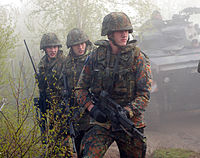Western armies are usually subdivided as follows:
- Corps: A Corps usually consists of two or more Divisions and is commanded by a Lieutenant General.
- Division: Each division is commanded by a Major General, and usually holds three Brigades including infantry, artillery, engineers and communications units in addition to logistics (supply and service) support to sustain independent action. Except for the Divisions operating in the mountains, all the Divisions have at least one armored unit, some have even more depending upon their functionality. The basic building block of all ground force combat formations is the infantry division. A typical division would hold three infantry brigades.
- Brigade: A Brigade is under the command of a Brigadier General or sometimes is commanded by a Colonel and comprises three or more Battalions of different units depending on its functionality. An independent brigade would be one that primarily consists of an artillery unit, an infantry unit, an armour unit and logistics to support its actions. Such a brigade is not part of any division and is under direct command of a corps.
- Battalion: Each battalion is commanded by a Colonel or sometimes by Lieutenant Colonel who commands roughly 600 to 750 soldiers. This number varies depending on the functionality of the regiment. A regiment comprises either three batteries or four companies - and other arms excluding armoured units that are organized into squadrons each under the command of a major and comprising individual subunits called sections (which are further divisible into platoons and squads).
Field army
A field army is composed of a headquarters, army troops, a variable number of corps typically between three to four, and a variable number of divisions, also between three to four. A battle is influenced at the Field Army level by transferring divisions and reinforcements from one corps to another to increase the pressure on the enemy at a critical point. Field armies are controlled by a General or Lieutenant General.
Formations


A particular army can be named or numbered to distinguish it from military land forces in general. For example, the First United States Army and the Army of Northern Virginia. In the British Army it is normal to spell out the ordinal number of an army (e.g. First Army), whereas lower formations use figures (e.g. 1st Division).
Armies (as well as army groups and theaters) are large formations which vary significantly between armed forces in size, composition, and scope of responsibility.
In the Soviet Red Army and the Soviet Air Force, "Armies" were actually corps-sized formations, subordinate to an Army Group-sized "front" in wartime. In peacetime, a Soviet army was usually subordinate to a military district.